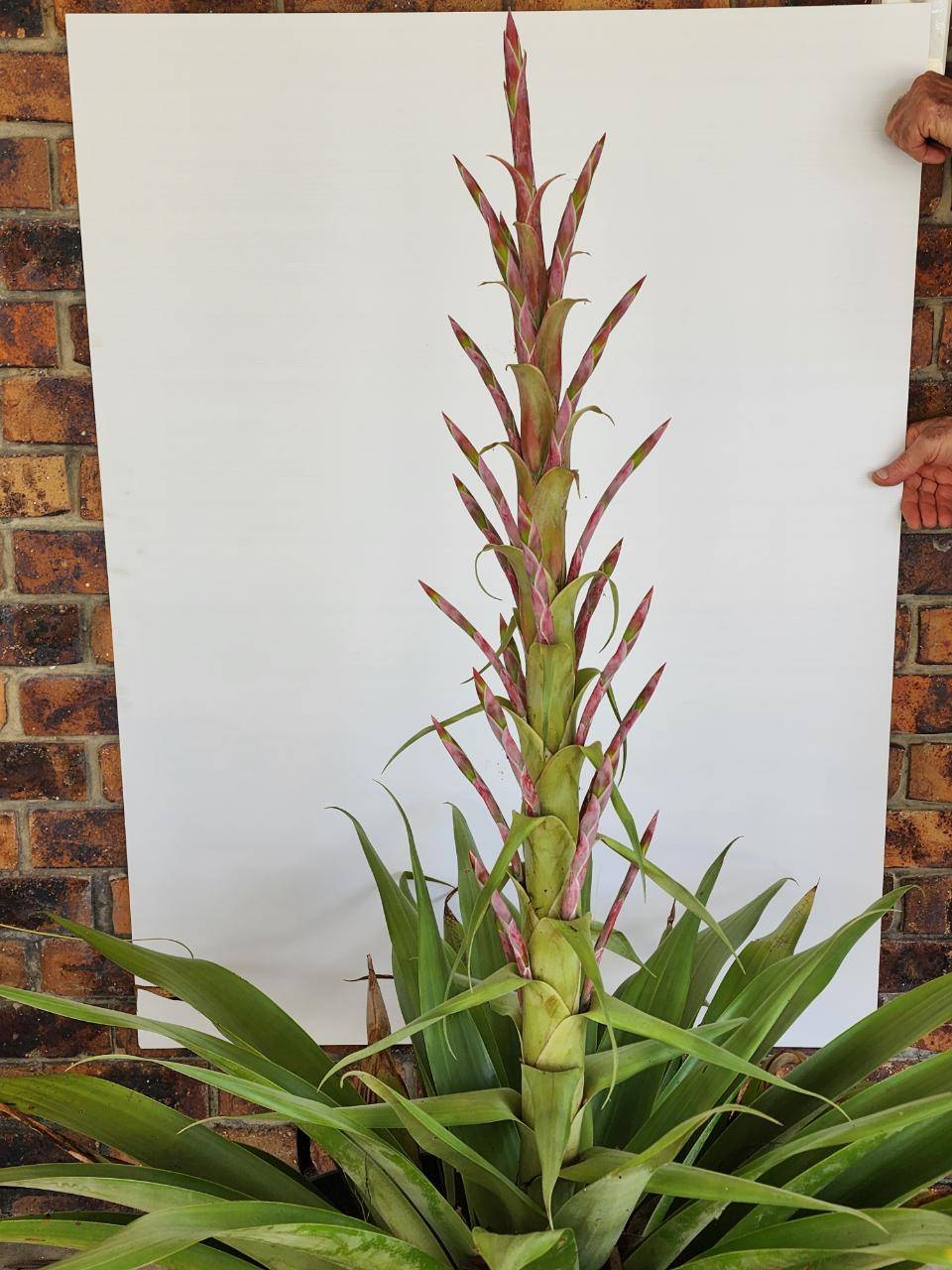
Tillandsia thyrsigera E. MORREN ex BAKER From investigation by Petra Hensel and Uwe Scharf: in Die Brom. 1:16-18. 2005
Tillandsia thyrsigera was described in 1889 by E. Morren in the Handbook of the Bromeliaceae. Because this book is no longer available in the trade and the plant is not very well known, we want to expand on the knowledge of this plant.
T. thyrsigera is a stemless rock tillandsia from Mexico where it occurs at 1700 to 2300 m high. The green grey, leathery leaves are wide and brownish at the base forming a dense rosette. It grows to 70 to 90 cm high. With flowers, the plant reaches a magnificent height from up to 2.3 m (Herbarium specimen in Missouri Bot. Garden MO). Since also significantly smaller specimens were found in flower at 90-150 cm high, it is to be assumed that the taxon can flower while small and only reaches the maximum size after many years and under optimal location conditions.
The inflorescence consists of several spikes and with sufficient light, the bracts are a wonderful pink red colour, the floral tube violet. The plant goes through its early development as strongly gray scaled and later forming a corresponding larger, more green rosette, where only the leaf-underside remains densely gray scaled. When quite young, plants produce adventitious offsets at the base, that are many years in the juvenile form before they take on the adult form.
It is unclear how the plant got its name, because a thyrse is a composite inflorescence, where the inflorescence part emerges from a cyme. That on the other hand is an inflorescence from which single flowers are at the end. As far as is known, Bromeliad inflorescences are always composed of spike, (sessile flowers), or panicle, (flowers stemmed), viz. the single flowers are on the side part. T. thyrsigera has an inflorescence of composite spikes or panicle. See example in Rauh (1990, Bromelien, p.38). Also Derek Butcher http://fcbs.org/articles/Thyrse.htm) wonders why the word 'thyrse' has found its way into the Bromeliad world.
The Type plant, Uhde 181, was collected in central Mexico. Unfortunately, no exact location is recorded. It was deposited in the Berlin herbarium (B), in 1889 together with one of E.Morren's ready made drawings as the type-voucher. However, the plant had been drawn from one that had already been some years in cultivation and that E. Morren had obtained from Kienast in Zurich. The species name is therefore based on, (1) material collected by Uhde in Mexico with the number 181 in the Berlin herbarium and, (2) the drawing by Morren. The material from Uhde from Mexico in (B) had been burnt at the end of World War II, (2 sheets) survived and are to be regarded as the Syntype (+Isosyntype). The drawing by Morren, whose whereabouts is unknown at present, (possibly in the Kew herbarium, K or Liege, LG), is the other Syntype. Dr. Till from Vienna has seen the sheets in (B) as Syntype annotated in the 1990's (mdl. Mitt. N. Kilian B). Based on the same Type material described by Mez in 1896 as T. uhdei Mez. This name is not valid.
In Mexico, State of Mexico, in the last 50 years there have been further collections in Temascaltepec (Guayabal), Valle de Bravo (Godines), Ixtapan de la Sal and Almoloya de Alquisiras (Cerro de Ahuacatitlan). Also Jurgen Brinkmann has found T. thyrsigera at 2300 m growing on rocks in the Valle de Bravo. It was found there with a large form of T. ignesiae and Pitcairnia heterophylla.
Culture:
Tillandsia thyrsigera is being grown in a few collections which we found out through extensive enquiry. The large size of the plant may be a reason. However, T. thyrsigera is extremely slow growing. Petra has looked after an adventitious offset, that has grown in 3 cm in 3 years, from 4 to 7 cm! Uwe reports on one approximately 5 cm high, which increases by approximately one leaf per year. The botanical garden in Halle in 1993 had three approximately 10 cm high adventitious offsets from the Valle de Bravo in Mexico. The plants are cultivated epiphytically and are now about 45 cm high with about 40 adventitious offsets. The plants are cultivated at 20C with a lower temperature at night.
The species can be grown as well as epiphytically in Pine bark mixture. Generally, it seems to be very tolerant to different cultural methods. In the winter, it can be cultivated cool and tolerates full sun in the summer. Then the leaves change to a wonderful red violet to brown-red. The strong gray scales and the erect quite wide leaf bases with their young offsets give an attractive appearance and for long time enrich many a collection.
Summary:
Tillandsia thyrsigera is an old species, described in 1889. It is a funnel-shaped dweller of vertical rocks and steep valleys and reaches a diameter of 90 cm and maximum height of 2.3 m during anthesis. The type collection (Uhde 181) is deposited in Berlin (B), the distribution of the species in the wild known to be restricted to Central Mexico. T. thyrsigera is rarely seen in private or public collections because of its large size when full grown. However, less mature examples are still a favourite of collectors since it stays a very long time in an attractive densely lepidote juvenile form. Propagation is straightforward, from adventitious shoots at the base.